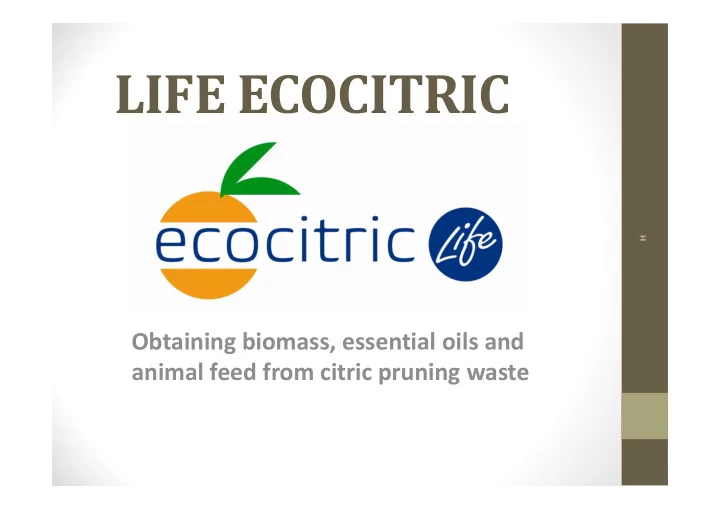

LIFE ECOCITRIC H Obtaining biomass, essential oils and animal feed from citric pruning waste
The Municipality of La Vall d'Uixó leads the Project that takes place within the Demonstration Environmental Programme LIFE in its 2013 call for proposals, within the priority Environment Policy and Governance. This project began officially on H 1st June 2014 , with a duration of 30 months up to 30 November 2016 .
Why is the project needed? • Spain is the largest producer of citrus fruit of the European Union and the 5 th in the world with an annual production over 5 million tons during last decade. • The Region of Valencia is the main citrus region at the H national level. • At La Vall d’Uixó, municipality the crops surface dedicated to citrus is 1.855 hectares , with a yearly production of about 10.700 tons of waste which management was very difficult and expensive for farmers.
Total amount of prune’s waste by variety generated at La Vall Variety Tn Variety Tn Arrufatina 362,78 Nadorcoot 51,90 Capola 1,07 Navelate 122,63 Clemenules 6.548,40 Orogrande 184,60 Clemenrubi 130,07 Orogros 1,07 H Clemensoon 21,22 Oronules 1.169,53 Esbal 116,61 Oroval 157,75 Fortune 24,38 Ortanique 410,61 Hernandina 529,05 Safor 1,07 Lane ‐ late 546,99 Terreno 43,72 Marisol 154,14 Tomatera 110,41 TOTAL 10.688,01 Tn
Waste management • Waste coming from citrus prune are burnt in crops fields without any type of leverage, producing a lot of air and land ‐ based pollution , apart from multiply the risk of forest fire . H • LIFE Ecocitric presents a waste recovery methodology for the full use of pruning citrus as biomass made into pellets, animal food and essential oils.
H
BIOMASS To get a high quality biomass, it is firstly needed to reduce the content of waste’s water . The wood fraction in the pilot plant undergoes a bio ‐ drying process by means of microbial action. H To obtain this product, first of all, is done a bio ‐ drying in greenhouse until humidity reaches 25% and subsequently a thermal drying using a biomass furnace. Then, the dry residue (with only 10% of humidity) is crushed and pelletized.
Bio ‐ drying system H
CHARACTERISTICS • Calorific on dry mass: 4110.21 kcal / kg • Calorific on wet mass: 3721.39 kcal / kg • Moisture content: 9.46% • Ashes on dry mass: 2.56% • Ashes on wet mass: 2.31% • Volatile matter on dry matter: 81% H • Volatile matter on dry mass: 73,34% • Diameter: 6 mm • Length: 3 <L <4 mm • Fixed carbon on dry mass: 16,44% • Fixed carbon on wet mass: 14.89% • Raw material: 100% pruning citrus
RESULT • In the demonstration plant was achieved the production of a biomass fuel draw from low cost raw material that can be sold as biomass made into pellet or be burnt to generate electric or thermic energy. H • The final energy balance is very positive because to dry 1kg of biomass are only required 0,048 kg of pellet . All of that indicates a performance efficiency of 94%. The pellets resulting from the process are accepted as fuel according to DIN 51731, 2012 standards.
ESSENTIAL OILS AND ANIMAL FEED Essential oils and animal feed will be obtained from the leaves , which undergo two treatment stages. H
1 . distillation and digestion process . In this process, CITRIC ESSENCES are obtained by means of steam distillation H
CHARACTERISTICS • Appearance : High purity, absence of foreign matter • Color : transparent straw ‐ H colored hue • Odor : Characteristic citric • Form : Liquid dense
RESULT he essences gotten from the leaves , contrary to the ones btained for example from the shell or from the flowers, have a ransparent colour and they contain aromatic substances alled terpene esters which behave as anti ‐ inflammatory, nalgesics and antispasmodics. H t is very common that they take part of the formulation of reparations used to treat a wide variety of pain such as migraines. By the same token, they can be used as painkillers and elaxants. In addition to the therapeutic use, the essences obtained can also be used in the food industry as natural avourings.
2. the remaining proteins and fats undergo dewatering, refining and pelleting to convert them into meal in granulated form that can be used as ANIMAL FEED with a high protein value. H
CHARACTERISTICS • ORGANOLEPTICS • Appearance: Absence of foreign material • Color: Greenish • Odor: Characteristic • Form: citrus meal compacted into a cylinder H • MICROBIOLOGICAL QUALITY • Salmonella (25 g. ABSENCE) • E. Coli (1 g) ABSENCE • Staphylococcal (CFU / g) <10 (LDD) • ABSENCE OF UNDESIRABLE SUBSTANCES (RD 465/2003)
• NUTRITIONAL PARAMETERS • AMINOGRAM • Aspartic acid 0,94% • Gross Protein 14% • glutamic acid 1,05% • Crude fat 2.5% • Alanine 0,54% • Crude fiber 17% • Arginine 0,59% • FAD 17% • Cysteine (aq. Citric) 0,17% • • Ash 12.5% Phenylalanine 0,52% • Glycine 0,64% • Moisture 8% • Histidine 0,25% • Starch <2% • Isoleucine 0,44% H • Total Sugars <2% • Leucine 0,79% • Lysine 0,51% • Methionine (Methionine sulfone) 0,18% • Proline 1,62% • Serine 0,47% • Threonine 0,34% • Tyrosine 0,45% • Tryptophan 0,19% • Valine 0,57%
H
H
More information: H
Recommend
More recommend